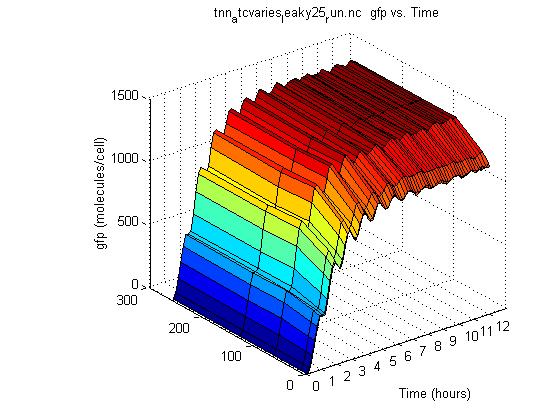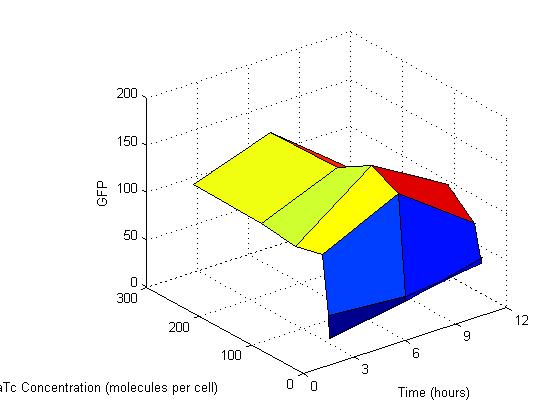Minnesota/10 July 2009
From 2009.igem.org
| Line 5: | Line 5: | ||
|'''[[Minnesota/9 July 2009|Go to Previous Day (July 9)]]'''|| width=158|'''[[Minnesota/13 July 2009|Go to Next Day (July 13)]]''' | |'''[[Minnesota/9 July 2009|Go to Previous Day (July 9)]]'''|| width=158|'''[[Minnesota/13 July 2009|Go to Next Day (July 13)]]''' | ||
|} | |} | ||
| - | <br> | + | '''Patrick'''<br> |
| + | Yesterday's results showed that lowing GFP production, while it had the potential to shift the amount of time it takes the system to reach steady state, it couldn't shift it enough even when the decomposition was set to zero. This was because cell division resulted in dilution that would make GFP reach a steady state after about 3 hours.<br> | ||
| + | |||
| + | The key to shifting this curve more is perhaps to change how the tetR2 molecules exist as complexes. In the TTN system tetR2 can exist by itself, as tetR2:tetO1, tetR2:aTc, tetR2:nsDNA, tetR2:tetO1:aTc, etc. about 11 different complexes. Today I focused on determining in which complexes tetR2 mostly existed as at the end of a simulation<br> | ||
| + | |||
| + | The results, obtained using a m-file I created, showed that at low aTc concentrations tetR2 was mostly bound to non-specific DNA (nsDNA), and floating about unbound (tetR2). At high concentrations of aTc all of it existed as tetR2:aTc2, which makes sense<br> | ||
| + | |||
| + | In trying to fit the experimental data, these results will be taking into consideration<br> | ||
| + | |||
| + | '''Ben'''<br> | ||
[[Image:Tnnatcvariesleaky25.jpg|480px]][[Image:Tnnexperiment.jpg|480px]]<br> | [[Image:Tnnatcvariesleaky25.jpg|480px]][[Image:Tnnexperiment.jpg|480px]]<br> | ||
Latest revision as of 19:19, 30 July 2009
| Back to Notebook Home | |
| Go to Previous Day (July 9) | Go to Next Day (July 13) |
Patrick
Yesterday's results showed that lowing GFP production, while it had the potential to shift the amount of time it takes the system to reach steady state, it couldn't shift it enough even when the decomposition was set to zero. This was because cell division resulted in dilution that would make GFP reach a steady state after about 3 hours.
The key to shifting this curve more is perhaps to change how the tetR2 molecules exist as complexes. In the TTN system tetR2 can exist by itself, as tetR2:tetO1, tetR2:aTc, tetR2:nsDNA, tetR2:tetO1:aTc, etc. about 11 different complexes. Today I focused on determining in which complexes tetR2 mostly existed as at the end of a simulation
The results, obtained using a m-file I created, showed that at low aTc concentrations tetR2 was mostly bound to non-specific DNA (nsDNA), and floating about unbound (tetR2). At high concentrations of aTc all of it existed as tetR2:aTc2, which makes sense
In trying to fit the experimental data, these results will be taking into consideration
 "
"

